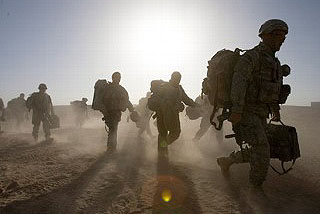 [For more on the WikiLeaks Afghan document dump, read posts by Dave Gilson here and Adam Weinstein here.]
[For more on the WikiLeaks Afghan document dump, read posts by Dave Gilson here and Adam Weinstein here.]
A long-awaited trove of secret government documents related to the war in Afghanistan has finally been released by WikiLeaks. There are about 92,000 documents in all, covering the years from 2004 through 2009. Three news organizations were allowed access to the documents several weeks ago on condition that they not write about it until today: the New York Times, the Guardian, and Der Spiegel. Both the Guardian and Times reports offer short bullet lists of the most dramatic revelations from the document dump. Although written independently, they’re pretty similar:
|
The Taliban have used portable heat-seeking missiles against allied aircraft, a fact that has not been publicly disclosed by the military. This type of weapon helped the Afghan mujahedeen defeat the Soviet occupation in the 1980s. |
How the US covered up evidence that the Taliban have acquired deadly surface-to-air missiles. |
|
Secret commando units like Task Force 373 — a classified group of Army and Navy special operatives — work from a “capture/kill list” of about 70 top insurgent commanders. These missions, which have been stepped up under the Obama administration, claim notable successes, but have sometimes gone wrong, killing civilians and stoking Afghan resentment. |
How a secret “black” unit of special forces hunts down Taliban leaders for “kill or capture” without trial. |
|
The military employs more and more drone aircraft to survey the battlefield and strike targets in Afghanistan, although their performance is less impressive than officially portrayed. Some crash or collide, forcing American troops to undertake risky retrieval missions before the Taliban can claim the drone’s weaponry. |
How the coalition is increasingly using deadly Reaper drones to hunt and kill Taliban targets by remote control from a base in Nevada. |
|
The Central Intelligence Agency has expanded paramilitary operations inside Afghanistan. The units launch ambushes, order airstrikes and conduct night raids. From 2001 to 2008, the C.I.A. paid the budget of Afghanistan’s spy agency and ran it as a virtual subsidiary. |
|
|
|
How the Taliban have caused growing carnage with a massive escalation of their roadside bombing campaign, which has killed more than 2,000 civilians to date. |
The Guardian has a very good collection of key documents here. WikiLeaks has the full document dump here. There are plenty of interesting details in the Guardian pieces, but if the bullet points above really are the biggest news from this trove, there’s not an awful lot there. The commando groups have hardly been a secret, while the increase in drone strikes, the CIA’s growing paramilitary activities, and the Taliban’s bombing campaign have not only not been a secret, they’ve practically been the center of PR campaigns to make sure everyone knows about them.
On the other hand, the news that the Taliban is using surface-to-air missiles is genuinely new, as is the revelation that even now the military isn’t entirely forthcoming about civilian casualties — though this apparently improved after Gen. Stanley McChrystal took over last year. Overall, however, the basic picture is basically the one we’ve known for a long time: a difficult, chaotic battlefield that’s shown little progress since the very beginning of the war.
















